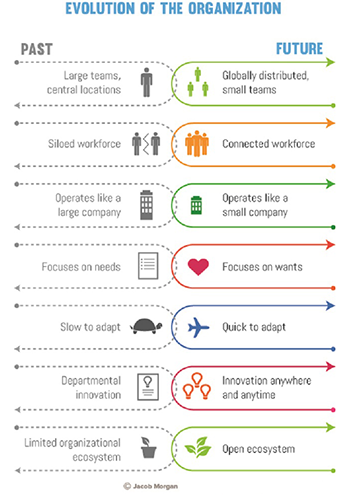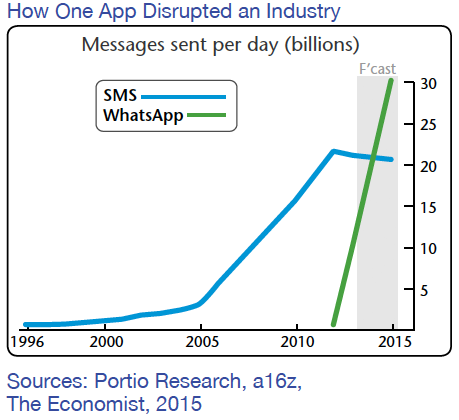
The Third Platform is a concept developed by analyst firm IDC. Gartner has a slightly different concept which they call ‘The Nexus of Forces and Cisco has this summer issued an interesting paper called ‘The Digital Vortex’ which moves the game on by examining the potential disruptive effect on business of the two analyst predictions.
This joint paper by Cisco and the Swiss Business School IMD in essence reports on yet another set of buzzwords prevalent today in the ICT sector, that being ‘Digital Transformation’ (DX) and Comms Business Magazine has introduced this concept throughout 2016 and will continue to do so. Overall however, no matter what term or name you use, there is tremendous change occurring in enterprises as they realise that doing more of the same only gets them the same result and that those competitors that embrace and implement the concepts of the Third Platform are outpacing and out performing them by a significant country mile.
More of this later.
 However, simply stated, and according to many analysts, the Third Platform is the next phase of the IT revolution. The first platform was the mainframe computer. The second was Personal Computers (PCs), which dominated the IT landscape from 1985 to 2005.
However, simply stated, and according to many analysts, the Third Platform is the next phase of the IT revolution. The first platform was the mainframe computer. The second was Personal Computers (PCs), which dominated the IT landscape from 1985 to 2005.
Of the components comprising the 3rd Platform mobile ICT is the biggest plank. Social networks, cloud, and Big Data are all accessed through these devices and, more often than not, the type of mobility is chosen by the worker – and we know this as BYOD.
If we take a look at the Third Platform to see how the components work together to produce a cost effective solution to business pain points for increased productivity, customer service excellence and speed to market then perhaps we can work out where resellers can leverage what CIOs and CTOs are looking at for their organisations.
I believe that the first thing we need to establish and understand is that the customers is at the heart of all of these transformational changes which is why I was pleased to see that this was covered in the first sentence when we spoke to Content Guru on the subject.
CMO Martin Taylor said, “The four pillars of technology which comprise the Third Platform have transformed the way consumers expect to interact with each other – and with organisations. Developments such as social media and mobile capabilities enable these consumers to engage at any time, from any place and across any device, and they are taking these demands and increased expectations from their personal lives to organisations.
Resellers now have the opportunity to effectively respond to these demands, through the always-on, multi-channel customer engagement hub, which marks the future of customer contact capabilities. The ubiquitous and instantaneous communications facilitated by social media and mobile data can be converged into single, manageable queues, processed by common rule engines and delivered to the best available resource.
By using a unified cloud platform, resellers are able to converge and manage these four technologies to deliver compelling, bespoke services to their customer for less, dramatically reducing business pain points. Not only can businesses now monitor and react to customer demands in a fraction of the time through instant access to real-time and historical reporting capabilities, but the constant stream of Big Data ensures that organisations never have to rely on the data of yesterday. And, instead of having to manage various siloed systems, leading cloud-based platforms converge functionality to create complete end-to-end services, which can leverage multiple channels, mobile capabilities and also mine data through Big Data capabilities.
 Big Data also feeds mass personalisation, which allows these organisations to treat every customer as an individual, regardless of the channel on which they choose to interact. Using intelligence to automatically treat certain enquiries in a particular way, and also route those through to a human agent if required, can deliver substantial efficiency gains to organisations.
Big Data also feeds mass personalisation, which allows these organisations to treat every customer as an individual, regardless of the channel on which they choose to interact. Using intelligence to automatically treat certain enquiries in a particular way, and also route those through to a human agent if required, can deliver substantial efficiency gains to organisations.
Using Propensity Modelling to analyse all available customer data and determine progression pathways, organisations no longer have to be reactive; data can be swiftly analysed to determine customer preferences and predict customer behaviours in a world that is constantly changing.
To be successful, companies need to learn how to use the third platform and to their advantage. Cloud services are at the very heart of this; with the growth of the BYOD culture and with more people working from home than ever before, cloud-services are becoming increasingly desirable; organisations need to have the flexibility to securely access Big Data - irrespective of their location.”
Martin Taylor concludes, “For resellers, the Third platform represents a significant opportunity from which they can create value for their clients by offering unique and differentiated propositions. This will not only help those organisations to stay ahead of the curve, but also resellers who are facing an increasingly competitive marketplace with the growth of confidence of cloud-based propositions that deliver the flexibility and agility they require.”
Mobility
Carl Boraman, Commercial Director at Tollring, picks up on the mobility element and how increased worker mobility enables employers to be more productive.
“Mobility can also help foster a better work life balance. However, this doesn’t mean the end of the office environment since certain roles and activities are better suited to a community setting.
We have found that BYOD is not particularly favoured, in fact it’s often seen as ‘bring your own disaster’. For mobile ICT to run smoothly, mobile devices need to be owned by the enterprise, with standardised technology and operating systems that can be supported effectively. This has led to a big growth in mobile device management software, so enterprises can control and secure their devices as well as ensure the security of information.
Moving to the Third Platform and increasing the use of mobile technology may require a major change to the way a customer traditionally operates. And whilst many of the phones, tablets and cloud-based apps are not new technology, it may still require a transition.
Interestingly, resellers may find that their customers are more open to change than they are. The CTOs are already educated about Third Platform services and they know that they need partners with proven successes and references. This is where user case studies, awards and certifications are important. It can be the key differentiator.
Resellers need to be the experts and help customers to make the right decisions for their organisations. This can only be achieved by fully understanding the customer’s business needs and concerns. Resellers must also have a full understanding of these new utility-based services. The selling process then focuses on building trust and being able to fully understand the pros and cons of different solutions.
Delivering more cloud-based services may mean that profits are delayed until many months into a contract. But if a reseller gets it right, they’ll have long term and strong relationships with their customers.”
Collaboration
A key element of implementing a Third Platform transformation is the need today to engender a collaborative ethos amongst employees and the abandonment of siloed single function management – a point at the heart of the comment from Paul Clarke, 3CX Regional Sales Manager for UK and Ireland.
“Unified Communications will be the critical technology in the evolution of the Third Platform. As businesses develop more complex solutions, combining different forms of IT, Unified Communications will be essential to getting information to the people who need it, and in connecting up remote and mobile workers, and in boosting productivity.
How will the Third Platform evolve? Businesses will require solutions that include mixes of technology with Big Data analytics, for example, working in tandem with communications -- consider what is happening around IBM’s Watson and communications applications. There is an ongoing shift of decision making from central IT to business units, where IT solutions are now seen as an intrinsic part of operations. The flexibility offered by third-platform technology will also enable businesses to rapidly scale their operations up and down as demands dictate.
Collaboration and information sharing are essential to the success of these IT-empowered business units. For these businesses to succeed, information must be shared across the enterprise, reaching mobile and remote workers whose expertise may be needed. Without Unified Communications, the operational conclusions reached by analytics using input from IoT would never reach the workers who can refine them and put them to use. And, as businesses scale up and down rapidly, Unified Communications will keep them operating through physical and personnel changes.
Resellers should emphasise the role of comms integration -- the use of Unified Communications from within Third Platform solutions. Customers will be asking resellers to assemble complex IT solutions; resellers need to have robust Unified Communications in order to make them work.
Mobility will also be an important element in providing the productivity boost businesses are seeking as they adopt these complex solutions. For these solutions to be effective, collaboration is an essential ingredient. Building successful marriages between Big Data analytics and other applications will involve contributions from workers all across the globe.
To make this happen, all the tools of Unified Communications will have to be put to work: Voice calls, chat, messaging, conferencing from anywhere at no extra cost 24/7/365. To play their role as business enablers, CIOs will have to choose robust, high-quality Unified Communications systems that can be relied upon to take on the challenge of vastly increased collaboration.
Resellers should understand how Unified Communications is already starting to take on this challenge. With CRM integration, communications systems are speeding collaboration as workers make calls without ever leaving their CRM apps. Contributions from workers anywhere in the enterprise can be solicited in real time, and this resolves customer issues and moves projects ahead faster. CRM integration in Unified Communications is a paradigm for what is to come, as comms becomes an intrinsic part of business solutions of all kinds.”
Clarke concludes by advising that resellers clearly must change their business models if they are to succeed in providing the solutions their business clients will require.
“They will have to work closely with businesses to see that they get the technology they need to implement Third Platform solutions. This will place a burden of increasing expertise on resellers -- it is imperative that they begin researching the best in class for each type of technology required, particularly for Unified Communications which will be a key driver of Third Platform implementations.”
Disruption
If you can remember typewriters and analogue machines you’ll believe the digital business world arrived some years ago. But it seems we have so far only seen the early demonstrations in the digital revolution.
As a move to prepare business leaders for the coming changes, IMD Business School and Cisco have announced a collaboration to develop thought leadership and address business challenges in digital transformation to all aspects of enterprises, in every industry.
Digital business transformation is a journey to adopt and deploy digital technologies and business models to improve performance quantifiably.
 The first step of this journey is to grasp the need for change—an imperative driven by the inevitability of digital disruption. Digital disruption now has the potential to overturn incumbents and reshape markets faster than perhaps any force in history. Simply put, digital disruption is the effect of digital technologies and business models on a company’s current value proposition, and its resulting market position.
The first step of this journey is to grasp the need for change—an imperative driven by the inevitability of digital disruption. Digital disruption now has the potential to overturn incumbents and reshape markets faster than perhaps any force in history. Simply put, digital disruption is the effect of digital technologies and business models on a company’s current value proposition, and its resulting market position.
The difference between digital disruption and traditional competitive dynamics comes down to two main factors: the velocity of change and the high stakes involved. Digital disruptors innovate rapidly, and then use their innovations to gain market share and scale far faster than challengers still clinging to predominantly physical business models.
In their 2016 Digital Vortex report IMD and Cisco cite the particularly striking case of WhatsApp, bought by Facebook in 2014 for a whopping $22 billion. WhatsApp’s overwhelming impact on the $100 billion global text messaging market delivers a powerful lesson in digital disruption.
Digital disruptors are particularly dangerous because they grow enormous user bases seemingly overnight, and then are agile enough to convert those users into business models that threaten incumbents in multiple markets. In addition to free text messaging, WhatsApp now allows users to make free mobile voice calls. It would be reasonable to expect WhatsApp to announce further disruptive moves in IVT sectors such as Payments and Mobile Advertising.
Ed Says… The key message we feel is that change is happening. For most people change will equate to disruption and many will bury their heads in the sand and ignore the digital imperative and others will optimistically hope to be ‘swift followers’ sometime in the future. Comfort zones are tricky to deal with but staying within your own looks to be a high risk strategy. The very least we would recommend our readers to do is research what others are saying and doing so at least you can take an informed view. One place to start could be the IMD Business School Digital Vortex report at www.imd.org
